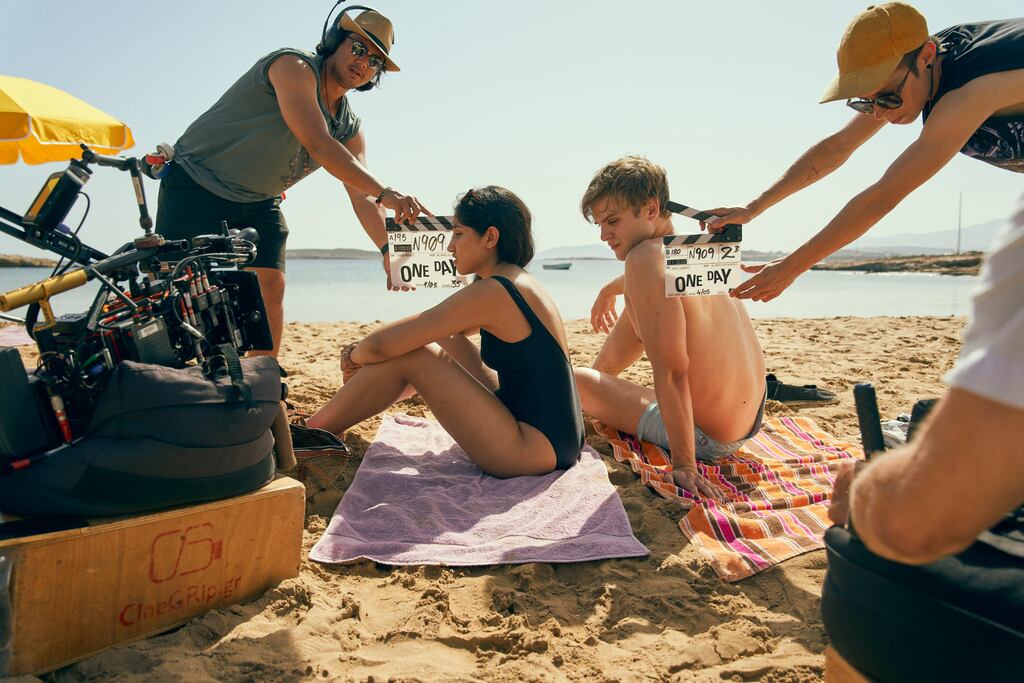Netflix’s critically praised One Day has variously been described as a Normal People for Gen X-ers, a 1990s nostalgiafest or an act of redemption for David Nicholls’s 2009 source novel, after a grim 2011 film version in which Anne Hathaway committed grievous bodily harm against the Leeds accent. It’s also the latest reminder of how well the bingeable half-hour episodic format works for certain types of story – in this case the will-they-won’t-they relationship between college friends Emma Morley and Dexter Mayhew over the course of 15 years from the late 1980s to the early years of the millennium.
The show is certainly nostalgic, but for what exactly? If anything it seems to deliberately underplay any sense of the period. Has so little changed in 30 years? Imagine a drama shot in 1994 and set in the early 1960s; there’d be a lot more work for the wardrobe and design departments to do.
Much of One Day looks and feels as if it could be happening today. (I tested this proposition with someone who hadn’t been born in the 1990s and they agreed, so it must be true.) There are quite a few 20-something men with luxuriant facial hair (implausible in 1997) and not much sign of bootcut jeans.
Instead, One Day does a lot with judicious use of a small number of well-chosen and heavily flagged props. A first-ever Nokia phone here. A dog-eared copy of The Unbearable Lightness of Being there. Most pointedly, a rediscovered mixtape that sparks the final (no spoilers here) narrative arc.
Miriam O’Callaghan: ‘Receptiongate was the most stressful moment of my entire career’
Netflix, Prime Video, Disney+, Apple TV+: 10 of the best new shows to stream in November
Ellen Keane: ‘I grew up believing I was unlovable, that I wasn’t attractive’
From France to Ireland: ‘I called my parents after two weeks and said I’m not coming back’
Ah yes, mixtapes (as they were never called at the time). If the 1990s gave us anything, it was the infiltration of fiction and drama by carefully curated compilations of contemporary pop, just at the point when home taping had passed its peak. Irvine Welsh’s Trainspotting was published in 1993, with Danny Boyle’s Britpoptastic film released in 1996. A hundred imitations followed. But even by the time Nick Hornby’s tape-based novel High Fidelity came out in 1995, the days of the music cassette were numbered. Rewritable CDs, MP3s and filesharing lay just ahead. iPods and Spotify wouldn’t be far behind. By the time the film version of High Fidelity came around in 2000, the mixtape was already becoming fixed in public consciousness as a romantic signifier of analogue paradise lost and the end of music as the ultimate marker of youthful identity.
“If you own all the music ever recorded in the entire history of the world, then who are you?” as Hornby asked in 2015, on the 25th anniversary of High Fidelity’s publication.
So it’s One Day’s soundtrack that does most of the nostalgic heavy lifting in the new series. From Frankie Knuckles and Pixies in the late 1980s to Magnetic Fields and Badly Drawn Boy around the millennium, by way of Portishead and Blur in the middle, it’s a pretty accurate representation of the musical tastes of a couple of postuniversity friends in the period. (The only rap is Public Enemy, which also seems accurate.) My colleague Donald Clarke points out that it’s highly unlikely Emma would have been listening to the then virtually forgotten Nick Drake, but that only highlights the accuracy of most of the picks.
Nicholls went one better than the original soundtrack when, to some excitement, he posted links to “extended mixtapes” for Em and for Dex on Spotify. Clocking in at seven hours and 16 minutes, Emma’s tape would have required five C90s and an awful lot of painstaking biro work. Ranging from Gil Scott-Heron to Can to Scritti Politti, it contrasts with Dexter’s more bog-standard choices, which include a lot of Oasis and far too much of The Verve.
Trawling through these lists, all of them to some degree rooted in the 1990s but not restricted to the music of that decade, one notices a shared sensibility. Certain names are everywhere. The Velvet Underground/Iggy Pop/David Bowie triumvirate is unavoidable. Krautrock gets a surprisingly strong showing, as do Nina Simone and Aretha Franklin, but of the prog and hard rock titans of the 1970s there is no sign. Fans of Cocteau Twins, Belle and Sebastian and Massive Attack will be happy. Nirvana and their grungy successors are entirely ignored, as are U2 and the Spice Girls. Whatever your musical preferences (and I’m on board with most of these), you get a sense of history being rewritten. Which, in a way, is what we were all trying to do when we were making our own tapes in the 1990s.














